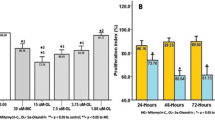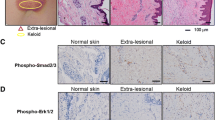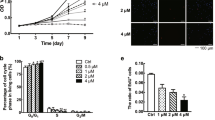Abstract
Background
Keloids have always been a difficult problem in the clinic. In our previous study, we demonstrated a Warburg effect in keloid fibroblasts (KFs), like tumors. In this study, we aimed to investigate the effects of the suppression of the Warburg effect on the biological activity and function of KFs.
Methods
KFs were isolated and cultured with different concentrations of oxamate, a classical competitive lactate dehydrogenase A (LDHA) inhibitor. First, the suppression effect of oxamate on the Warburg effect in KFs was verified. After treatment with oxamate, a scratch wound assay, real-time PCR, flow cytometry, CCK8 kit, and western blotting were used to detect the migration ability, collagen production, apoptosis, cell proliferation, cell cycle distribution, and related molecular mechanisms in KFs.
Results
As expected, oxamate inhibited the Warburg effect in KFs in a dose-dependent manner. After the inhibition of the Warburg effect in KFs, the cell migration rate decreased significantly, the mRNA transcription levels of type I collagen and α-SMA were significantly lower, the cell apoptosis rate increased significantly, the cell proliferation activity decreased significantly, and G0/G1 phase cells in KFs increased significantly. The expression of cyclin D1 and its upstream regulatory factors, Akt protein and GSK3 β (phospho S9), decreased significantly.
Conclusion
Inhibiting the Warburg effect in KFs significantly suppressed cell proliferation, enhanced cell apoptosis, inhibited cell migration ability, reduced collagen secretion, and induced G0/G1 arrest through the Akt-GSK3β-Cyclin D1 pathway. Therefore, inhibiting the Warburg effect in KFs may provide a new option for the prevention and treatment of keloids.
Level of Evidence IV
This journal requires that authors assign a level of evidence to each article. For a full description of these Evidence-Based Medicine ratings, please refer to the Table of Contents or the online Instructions to Authors www.springer.com/00266.







Similar content being viewed by others
References
Mohammadi AA, Kardeh S, Motazedian GR, Soheil S (2019) Management of ear keloids using surgical excision combined with postoperative steroid injections. World J Plast Surg 8:338–344
Mathangi RK, Babu M, Lakshmi MM (2015) Response of keloid fibroblasts to vitamin D3 and quercetin treatment—in vitro study. Ann Burns Fire Disasters 28:187–191
Bao Y, Xu S, Pan Z, Deng J, Li X, Pan F, Li X (2020) Comparative efficacy and safety of common therapies in keloids and hypertrophic scars: a systematic review and meta-analysis. Aesthet Plast Surg 44:207–218
Su Z, Jiao H, Fan J, Liu L, Tian J, Gan C, Yang Z, Zhang T, Chen Y (2021) Warburg effect in keloids: a unique feature different from other types of scars. Burns 48:176–183
Liu X, Yang Z, Chen Z, Chen R, Zhao D, Zhou Y, Qiao L (2015) Effects of the suppression of lactate dehydrogenase a on the growth and invasion of human gastric cancer cells. Oncol Rep 33:157–162
Jin L, Chun J, Pan C, Alesi GN, Li D, Magliocca KR, Kang Y, Chen ZG, Shin DM, Khuri FR, Fan J, Kang S (2017) Phosphorylation-mediated activation of LDHA promotes cancer cell invasion and tumour metastasis. Oncogene 36:3797–3806
Zhai X, Yang Y, Wan J, Zhu R, Wu Y (2013) Inhibition of LDH-A by oxamate induces G2/M arrest, apoptosis and increases radiosensitivity in nasopharyngeal carcinoma cells. Oncol Rep 30:2983–2991
Koukourakis MI, Giatromanolaki A (2019) Warburg effect, lactate dehydrogenase, and radio/chemo-therapy efficacy. Int J Radiat Biol 95:408–426
Ding H, Jiang L, Xu J, Bai F, Zhou Y, Yuan Q, Luo J, Zen K, Yang J (2017) Inhibiting aerobic glycolysis suppresses renal interstitial fibroblast activation and renal fibrosis. Am J Physiol Ren Physiol 313:F561–F575
Ngo H, Tortorella SM, Ververis K, Karagiannis TC (2015) The Warburg effect: molecular aspects and therapeutic possibilities. Mol Biol Rep 42:825–834
Warburg O (1956) On the origin of cancer cells. Science 123:309–314
Brooks GA (2018) The Science and translation of lactate shuttle theory. Cell Metab 27:757–785
Kanno T, Sudo K, Maekawa M, Nishimura Y, Ukita M, Fukutake K (1988) Lactate dehydrogenase M-subunit deficiency: a new type of hereditary exertional myopathy. Clin Chim Acta 173:89–98
Sudo K (2002) Lactate dehydrogenase M subunit deficiency. Rinsho Byori 50:571–575
Xie H, Valera VA, Merino MJ, Amato AM, Signoretti S, Linehan WM, Sukhatme VP, Seth P (2009) LDH-A inhibition, a therapeutic strategy for treatment of hereditary leiomyomatosis and renal cell cancer. Mol Cancer Ther 8:626–635
Yang Y, Su D, Zhao L, Zhang D, Xu J, Wan J, Fan S, Chen M (2014) Different effects of LDH-A inhibition by oxamate in non-small cell lung cancer cells. Oncotarget 5:11886–11896
Miskimins WK, Ahn HJ, Kim JY, Ryu S, Jung YS, Choi JY (2014) Synergistic anti-cancer effect of phenformin and oxamate. PLoS ONE 9:e85576
Luo L, Li J, Liu H, Jian X, Zou Q, Zhao Q, Le Q, Chen H, Gao X, He C (2017) Adiponectin is involved in connective tissue growth factor-induced proliferation, migration and overproduction of the extracellular matrix in keloid fibroblasts. Int J Mol Sci 18:1044
Zhang Y, Zhang L, Lin X, Li Z, Zhang Q (2017) Knockdown of IRF3 inhibits extracellular matrix expression in keloid fibroblasts. Biomed Pharmacother 88:1064–1068
Syed F, Ahmadi E, Iqbal SA, Singh S, McGrouther DA, Bayat A (2011) Fibroblasts from the growing margin of keloid scars produce higher levels of collagen I and III compared with intralesional and extralesional sites: clinical implications for lesional site-directed therapy. Br J Dermatol 164:83–96
Jiao H, Dong P, Yan L, Yang Z, Lv X, Li Q, Zong X, Fan J, Fu X, Liu X, Xiao R (2016) TGF-β1 induces polypyrimidine tract-binding protein to alter fibroblasts proliferation and fibronectin deposition in keloid. Sci Rep Uk 6:38033
Yao F, Zhao T, Zhong C, Zhu J, Zhao H (2013) LDHA is necessary for the tumorigenicity of esophageal squamous cell carcinoma. Tumor Biol 34:25–31
Acknowledgements
This study was supported by the National Natural Science Foundation of China (No. 8180081563).
Author information
Authors and Affiliations
Corresponding author
Ethics declarations
Conflict of interest
The authors declare that they have no conflict of interest.
Additional information
Publisher's Note
Springer Nature remains neutral with regard to jurisdictional claims in published maps and institutional affiliations.
Rights and permissions
About this article
Cite this article
Su, Z., Fan, J., Liu, L. et al. Inhibiting Warburg Effect Can Suppress the Biological Activity and Secretion Function of Keloid Fibroblasts. Aesth Plast Surg 46, 1964–1972 (2022). https://doi.org/10.1007/s00266-022-02899-3
Received:
Accepted:
Published:
Issue Date:
DOI: https://doi.org/10.1007/s00266-022-02899-3




